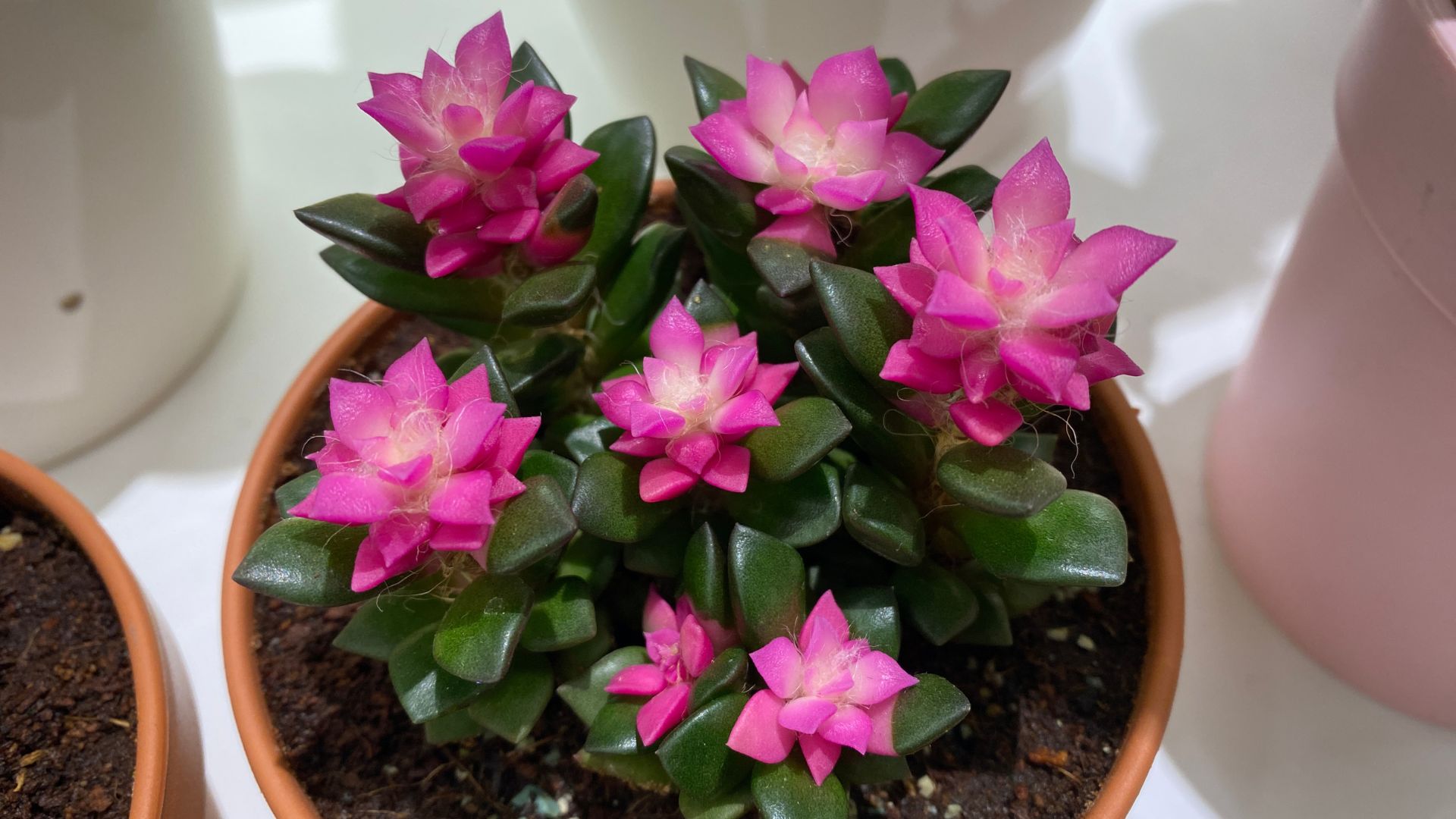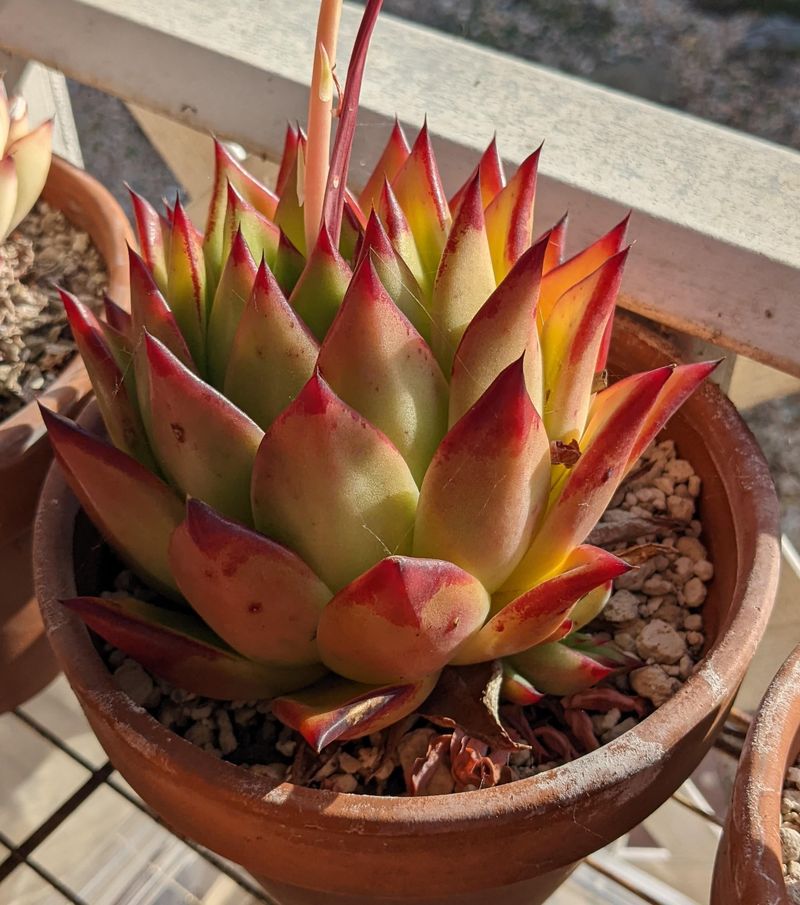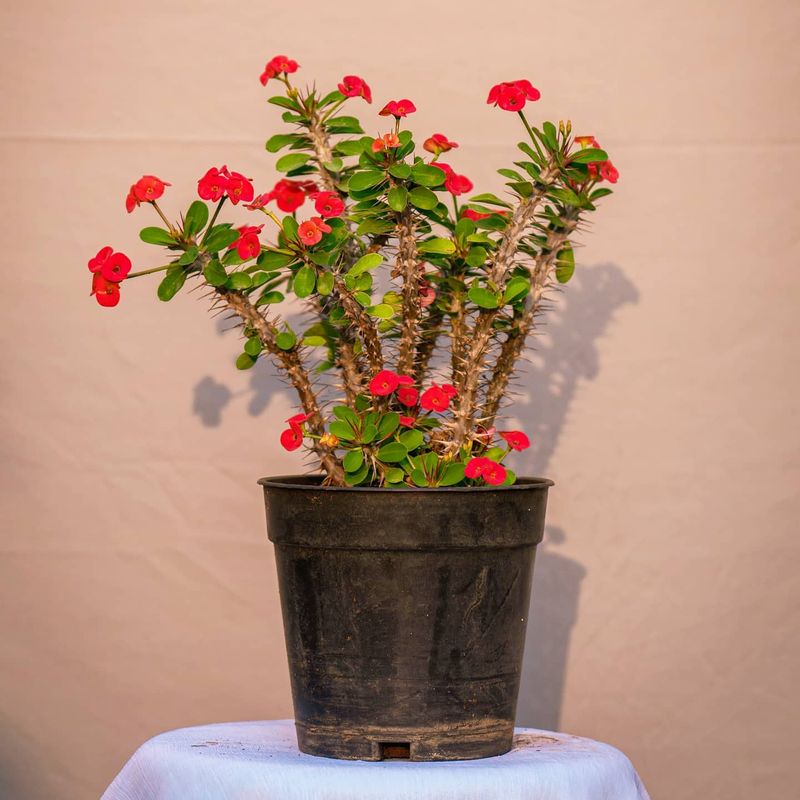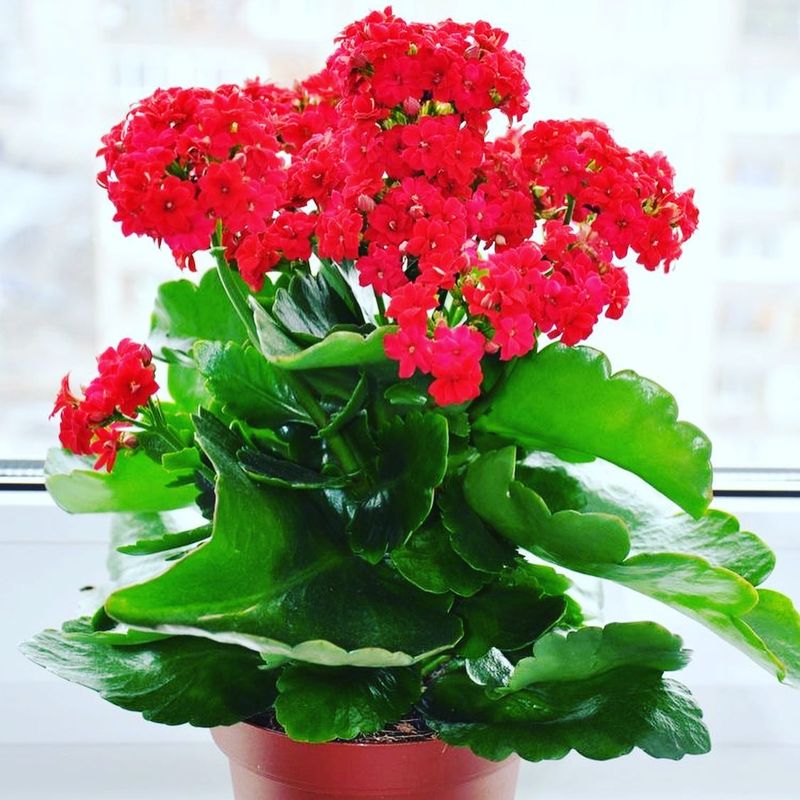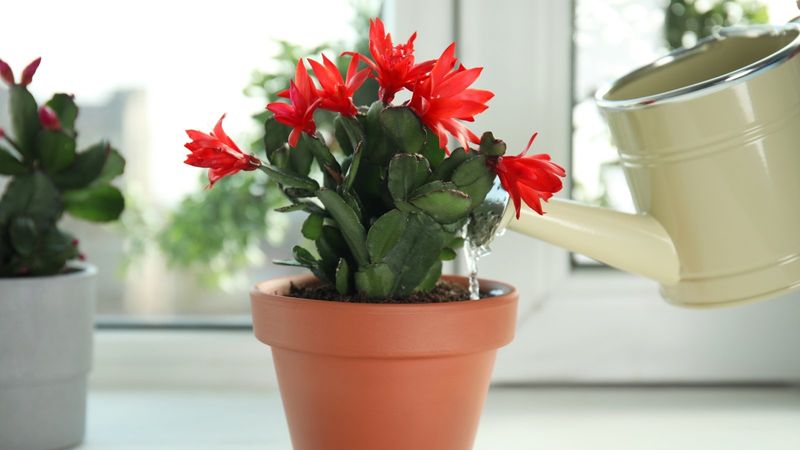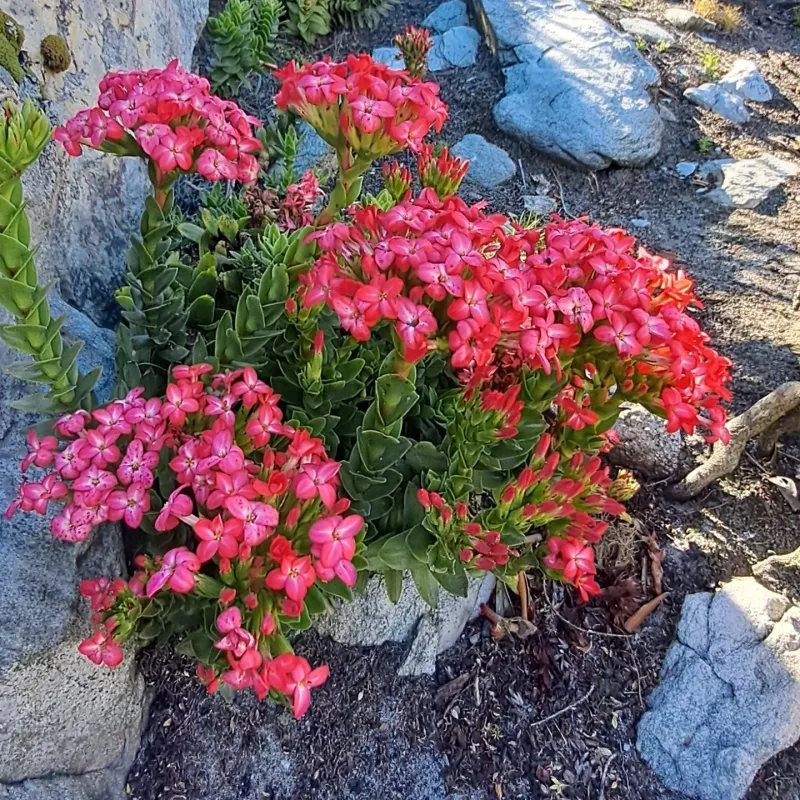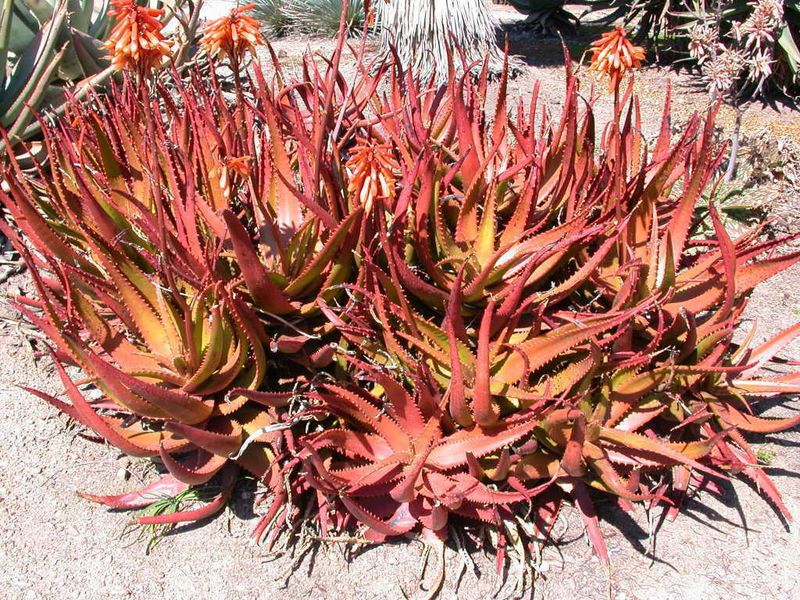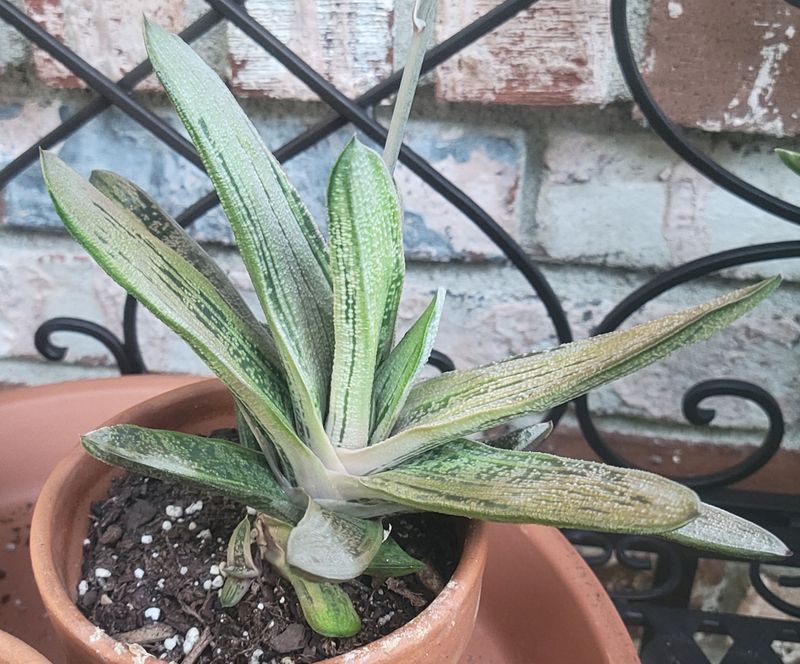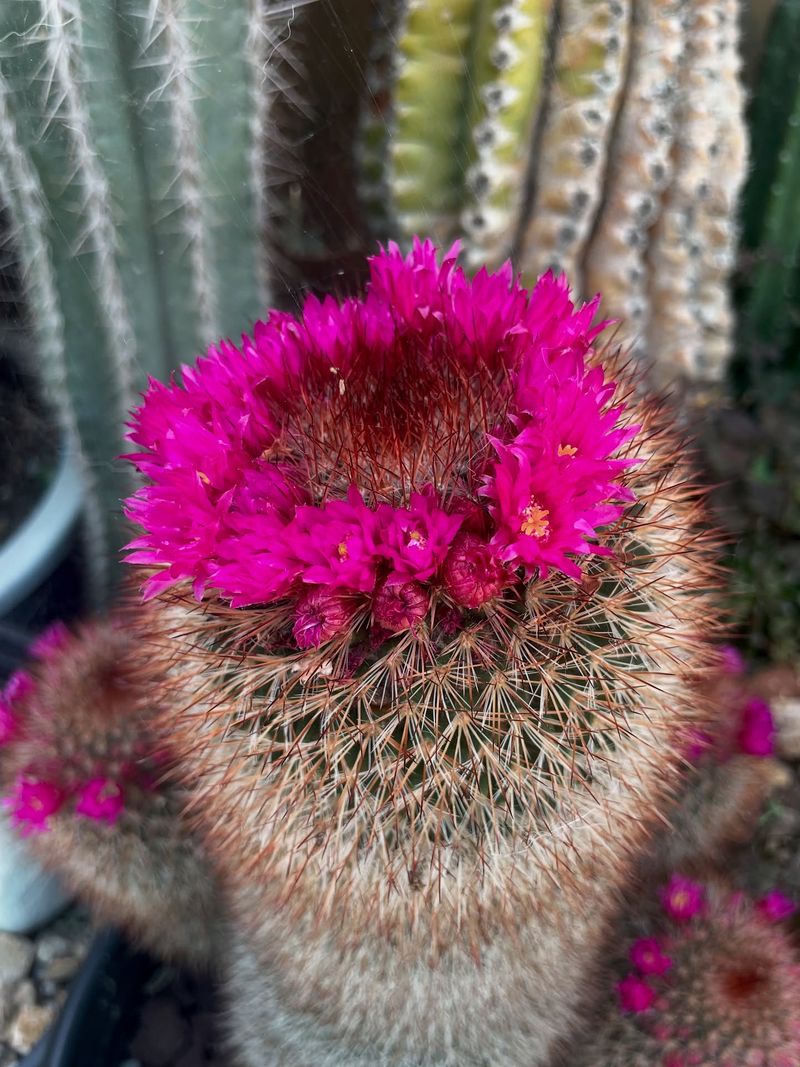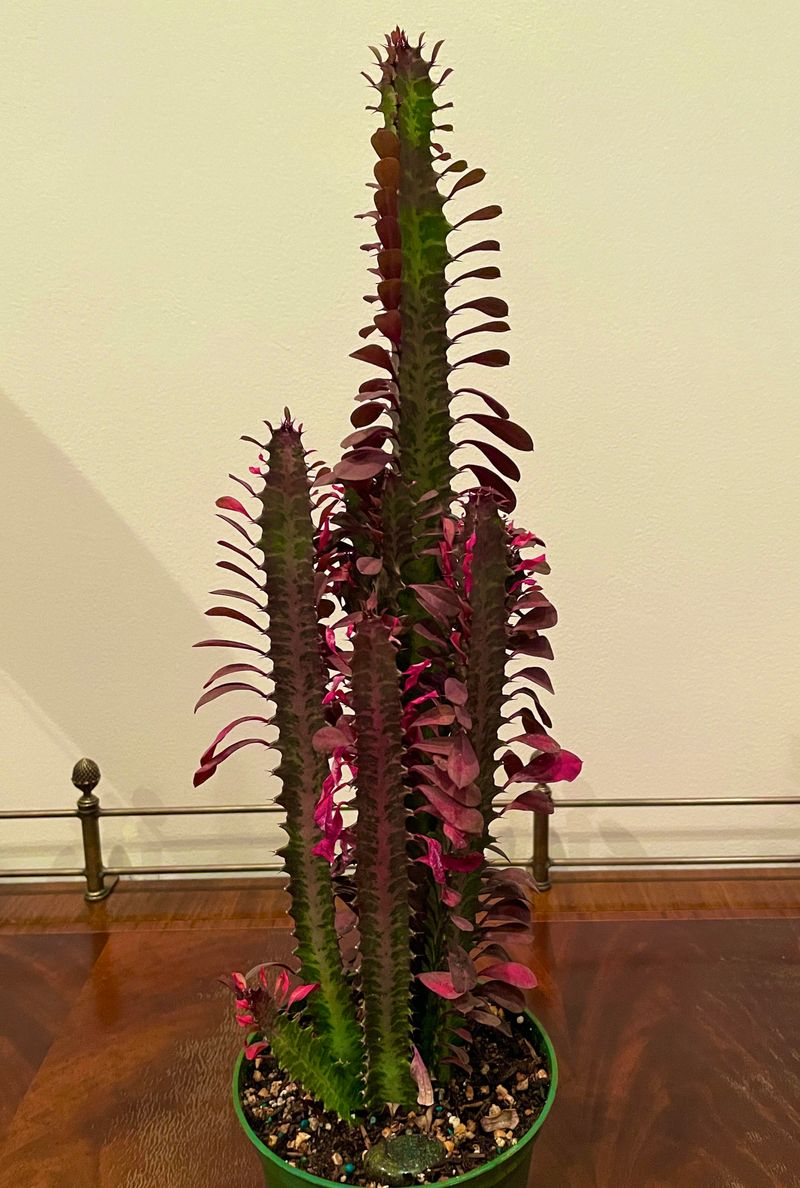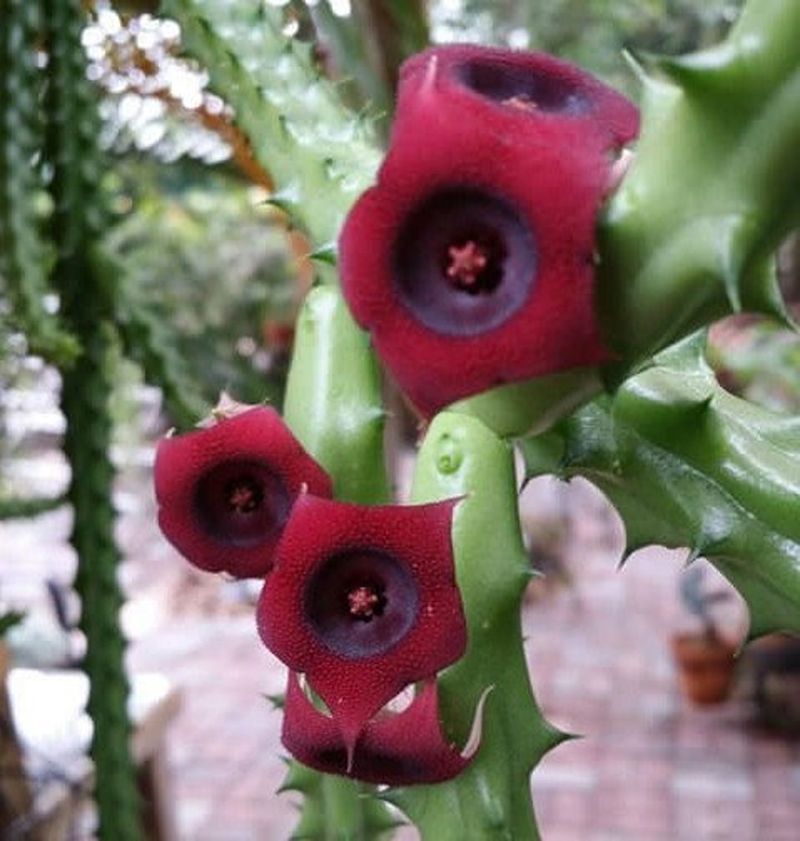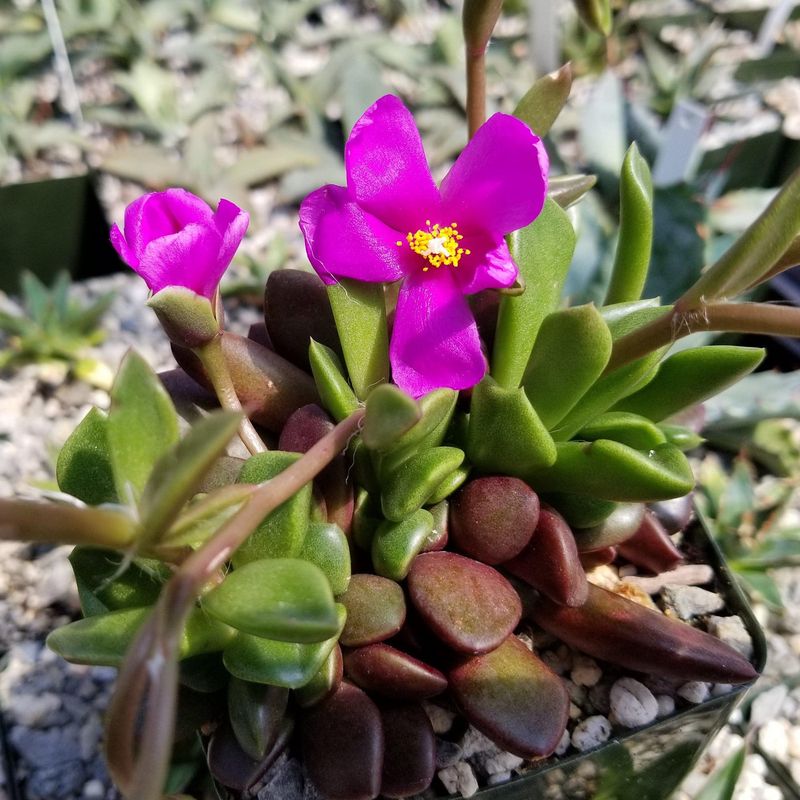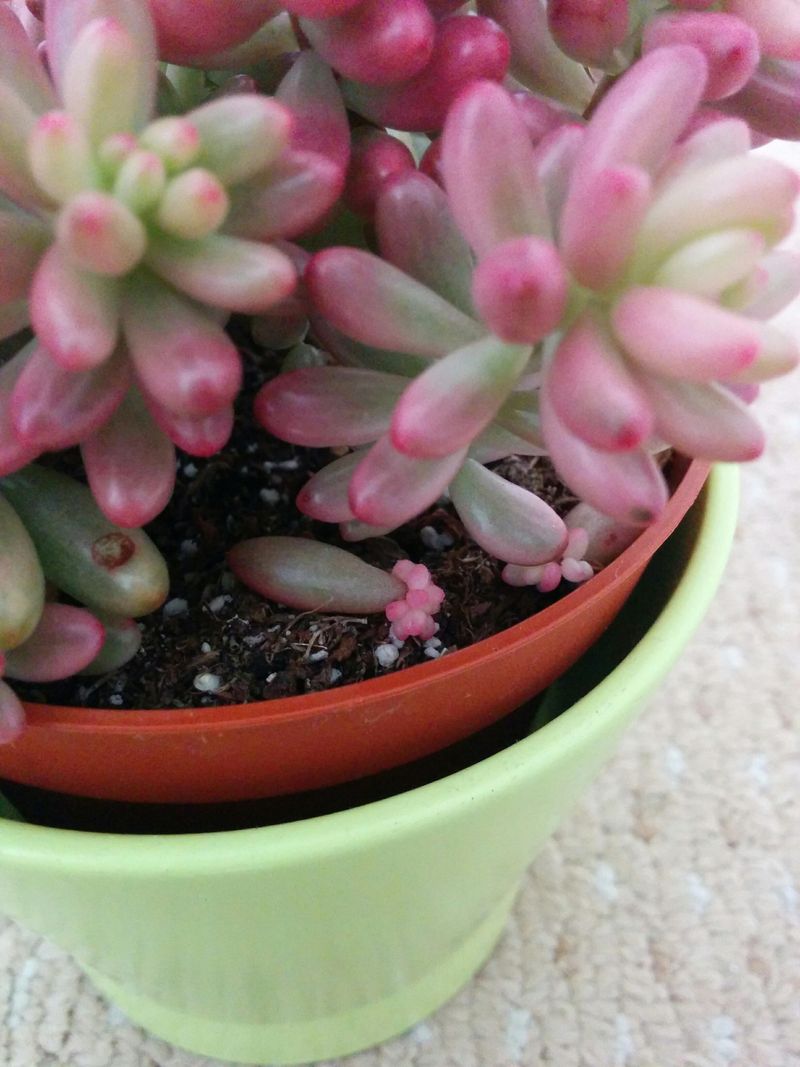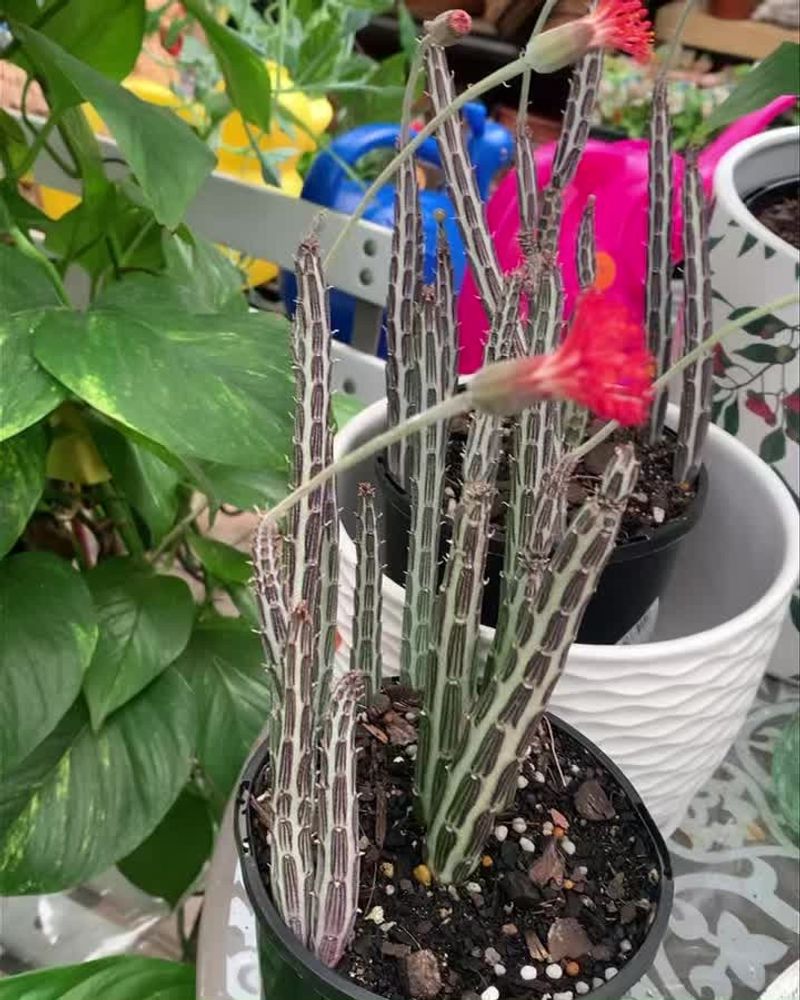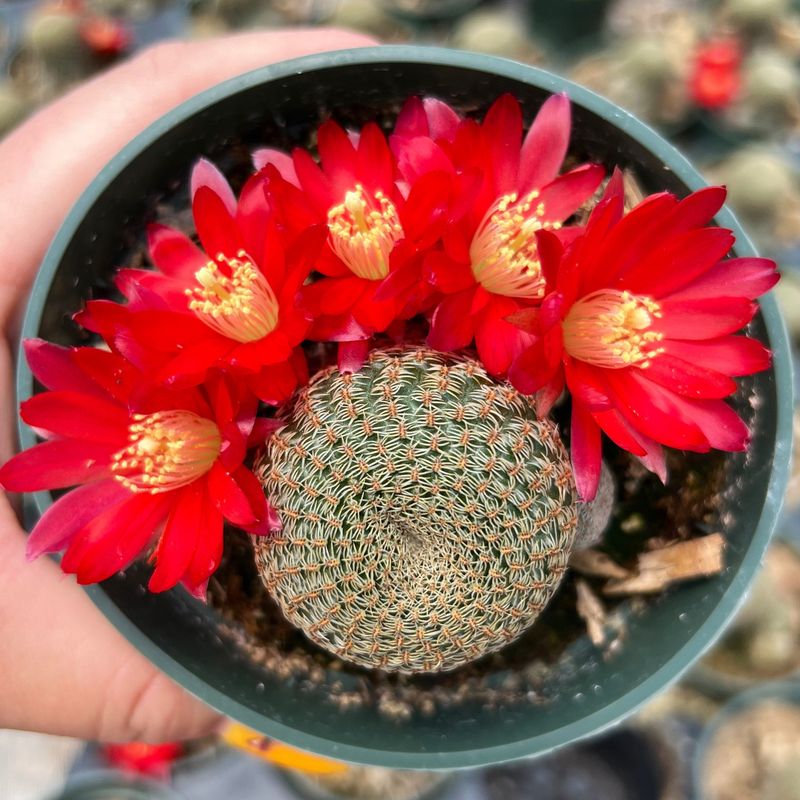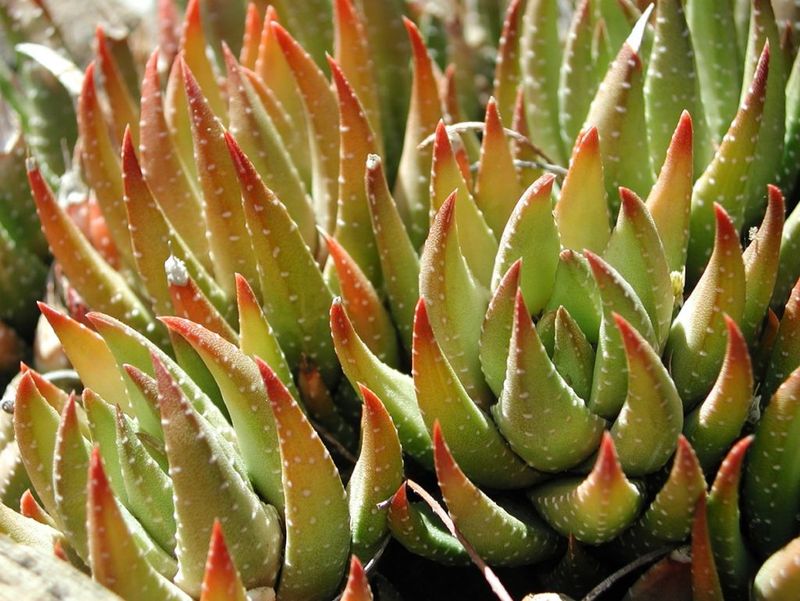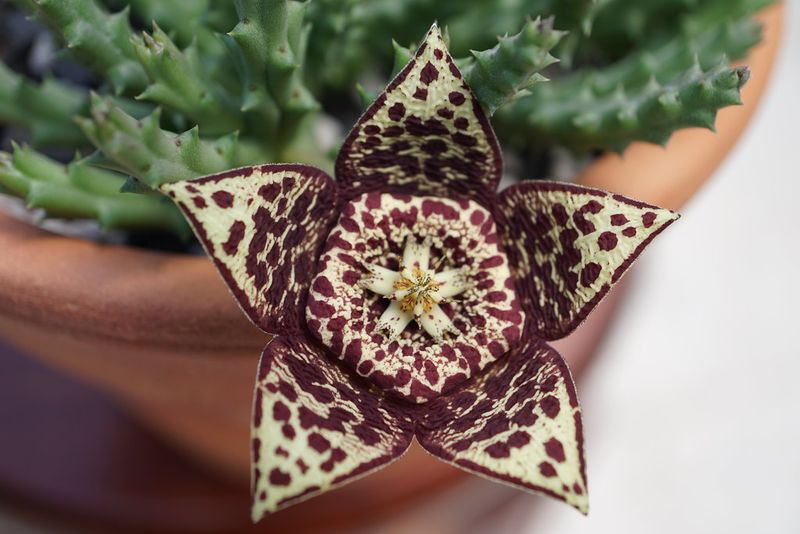Red-flowering succulents are like little surprises tucked into your indoor garden—just when you think you’ve seen it all, they burst into bloom. Most people picture succulents as green, tough, and maybe a little plain, but some of them really know how to put on a show.
Those crimson blooms can turn a basic windowsill into something that actually catches your eye every time you walk by.
And the best part? These plants don’t demand much from you at all. They’re drought-tolerant, low-maintenance, and perfect for anyone who loves bold color but doesn’t have time for fussy houseplants.
1. Echeveria ‘Lipstick’
The rosette-shaped leaves form a perfect backdrop for the brilliant crimson flowers that emerge on tall stems. Morning sun exposure encourages the most vibrant blooms, usually appearing in late spring to early summer.
Water sparingly once the soil dries completely. Too much moisture can cause root rot, killing even the healthiest specimen. A south-facing windowsill provides ideal growing conditions.
My first ‘Lipstick’ surprised me by flowering twice in one season when I moved it to a brighter spot. The stalks grow up to 10 inches tall, creating a dramatic display above the compact rosette.
2. Crown Of Thorns (Euphorbia milii)
Tiny red blooms appear year-round on this tough little plant, creating a continuous display unlike most seasonal succulents. The woody stems feature sharp thorns, so careful handling is essential when watering or repositioning.
Bright, indirect light keeps the flowers coming consistently. A remarkable survivor, this plant tolerates occasional neglect without complaint. Some varieties feature variegated foliage for added visual interest.
During winter months, reduce watering slightly but don’t let it dry out completely. I’ve had one specimen bloom continuously for three years on my east-facing kitchen windowsill with minimal care.
3. Kalanchoe blossfeldiana
Clusters of tiny scarlet flowers hover above thick, scalloped green leaves for weeks at a time. After the initial bloom fades, a period of reduced light triggers another flowering cycle, making this one of the most reliable rebloomers.
Moderate watering keeps the plant happy, allowing soil to dry between drinks. Removing spent flower heads encourages fresh blooms to develop. Commercial growers often force holiday blooming, but with proper care, natural cycles emerge.
Last year’s Mother’s Day gift surprised everyone by producing three full bloom cycles. The compact growth habit makes it perfect for tight windowsill spaces where other flowering plants might become too leggy.
4. Christmas Cactus (Schlumbergera buckleyi)
Cascading stems produce tubular ruby flowers during winter months, perfectly timed for holiday displays. Unlike desert cacti, this forest-dwelling relative prefers higher humidity and less direct sunlight.
Flower buds form when nights grow longer in fall. Moving the plant to a cooler location where it receives 12-14 hours of darkness encourages spectacular blooming. Overwatering causes more problems than underwatering with this particular species.
My grandmother’s Christmas cactus is over 30 years old and still produces hundreds of blooms each December. The trailing growth habit makes it especially attractive in hanging planters or elevated spots where stems can gracefully drape over edges.
5. Crassula coccinea (Red Crassula)
Clusters of star-shaped scarlet flowers crown this compact jade relative during summer months. The fleshy leaves grow in tight, stacked formation, creating an architectural look even when not in bloom.
Native to South African mountain regions, it thrives in bright light with good air circulation. Watering should be minimal in winter and moderate during active growth periods. Fertilize sparingly to avoid leggy growth.
Unlike many red-flowering succulents, the blooms last for several weeks rather than days. The contrast between deep green foliage and brilliant red flowers creates a striking display that draws attention even among larger houseplants.
6. Aloe cameronii (Red Aloe)
Striking coral-red tubular flowers rise on tall stalks above rosettes of reddish-bronze leaves. During drought or strong sun exposure, the foliage intensifies to a deep burgundy color, creating a monochromatic effect when blooming.
Winter and spring typically bring the most impressive flower displays. Unlike medicinal aloes, this variety is primarily ornamental, though it shares the same low-water requirements. A terra cotta pot helps prevent overwatering.
Moving my specimen from a north-facing to south-facing window transformed its color completely within weeks. The hummingbirds that visit my garden go crazy for the nectar-rich tubular flowers when I place it outside during summer.
7. Gasteria ‘Little Warty’
Dangling tubular flowers in shades of crimson and pink appear on arching stems above textured, tongue-shaped leaves. The unusual spotted foliage provides year-round interest even when the plant isn’t flowering.
Partial shade works better than full sun for this adaptable little succulent. The compact size makes it perfect for windowsills with limited space. Blooms typically appear in late winter to early spring.
Despite the somewhat unappealing name, the warty texture of the leaves creates interesting patterns as light filters through. A slow grower that won’t quickly outgrow its space, making it ideal for collectors with limited room for their plant collections.
8. Mammillaria spinosissima (Red-Headed Irishman)
Rings of vibrant magenta-red flowers crown this cylindrical cactus in spring, creating a halo effect above the densely-spined body. The contrast between white spines and crimson blooms makes for a striking display that lasts several weeks.
Extremely drought-tolerant, this cactus requires minimal watering and thrives in bright windowsill conditions. A fast-draining cactus mix prevents root issues common to overwatered specimens. Full sun brings out the most impressive flowering.
Small size at maturity (usually under 8 inches tall) makes this perfect for limited spaces. The spines look intimidating but actually feel soft to the touch – though I wouldn’t recommend testing this theory too enthusiastically!
9. Euphorbia trigona rubra (African Milk Tree)
Tiny red flowers occasionally emerge along the dramatic upright stems of this structural succulent. The real show comes from the burgundy-red coloration of the stems and small leaves that line the distinctive ridges.
Growth can reach impressive heights even in containers, sometimes exceeding three feet tall on a windowsill. Careful handling is essential as the milky sap causes skin irritation. Bright, indirect light maintains the rich coloration.
My specimen doubled in size over just one summer when placed in a south-facing window. The architectural quality of this plant makes it an excellent focal point, with or without its occasional modest flowers.
10. Huernia schneideriana (Red Dragon Flower)
Star-shaped flowers with an otherworldly appearance emerge directly from fleshy, ridged stems. The deep red blooms feature intricate patterns and a glossy surface that appears almost artificial in its perfection.
Relatively uncommon in general houseplant collections, this conversation starter produces flowers sporadically throughout the year. Low-growing stems spread rather than grow tall, making it perfect for shallow windowsill containers.
Despite the exotic appearance, care requirements remain simple – bright indirect light and minimal water. The unusual flowers sometimes emit a slight odor to attract their natural pollinators, though it’s rarely noticeable unless you get very close.
11. Anacampseros rufescens
Small but eye-catching pink-red flowers open for just a few hours during bright afternoons. The rosettes of purple-tinged leaves are covered with fine white hairs, creating a frosted appearance that contrasts beautifully with the bright blooms.
Morning sun brings out the best coloration in the compact foliage. Though the flowers are short-lived, they appear frequently during warm months. The entire plant rarely exceeds 4 inches in height.
Growing mine in a shallow terra cotta dish created a miniature landscape effect as it gradually spread. The fine white hairs that cover the leaves serve a practical purpose – they help the plant collect moisture from the air in its native habitat.
12. Sedum rubrotinctum ‘Aurora’ (Pink Jelly Bean)
Star-shaped crimson flowers appear atop stems covered in plump, rounded leaves that resemble colorful jelly beans. The leaf tips blush pink to red with sun exposure, creating a candy-like appearance that delights visitors.
Trailing stems cascade beautifully over pot edges as the plant matures. Propagation happens effortlessly – fallen leaves quickly root and form new plants. Bright windowsills bring out the strongest color in both foliage and flowers.
During summer heat waves, the entire plant can turn a surprising shade of pinkish-red. The flowers appear most prolifically after a period of slight drought stress, followed by regular watering – nature’s way of ensuring reproduction when conditions improve.
13. Stapelia gigantea (Carrion Flower)
Enormous star-shaped red-brown flowers can reach 10-12 inches across, making them some of the largest blooms in the succulent world. The intricate surface patterns and unusual coloration draw immediate attention from anyone passing by your windowsill.
Fuzzy stems with a blue-green hue grow in clumps rather than gaining height. The plant earned its common name from the distinctive scent of the flowers, which mimics decaying meat to attract pollinating flies. Keeping it on an open-air windowsill minimizes any odor issues.
Despite the intimidating flower size, the plant itself remains relatively compact. Blooms typically appear in late summer to fall when days begin to shorten.
14. Senecio stapeliiformis
Unusual red-orange daisy-like flowers emerge from pencil-thin, upright green stems covered in geometric patterns. The cylindrical growth habit creates a sculptural effect even when not in bloom.
Native to South African deserts, this oddity requires minimal water and thrives in bright windowsill conditions. The flowers appear sporadically throughout warm months, often surprising owners who may have given up on seeing blooms.
My specimen survived complete neglect during a two-week vacation and greeted me with flowers upon my return. The upright stems can reach 12 inches tall but grow slowly, making this an excellent long-term windowsill companion that won’t quickly outgrow its space.
15. Rebutia fiebrigii
Masses of funnel-shaped scarlet flowers completely cover this small, round cactus during spring blooming season. The dramatic display often hides the plant body entirely for several weeks, creating a ball of brilliant color.
Among the most reliable flowering cacti for indoor cultivation, even young specimens produce abundant blooms. The diminutive size (rarely exceeding 2-3 inches in diameter) makes it perfect for the narrowest windowsills.
Despite the intimidating cactus classification, the spines are soft enough to handle without special tools. A cool winter rest period with minimal water encourages the most spectacular spring flowering display.
16. Haworthia cymbiformis var. reddii
Translucent ruby-tinted rosettes catch and filter light beautifully on sunny windowsills. While the flowers are small and whitish-pink on tall stems, the real attraction is the red-tinged foliage that intensifies with sun exposure.
Perfect for north or east-facing windows where other succulents might struggle. The compact growth habit keeps it windowsill-appropriate for years without repotting. Leaf tips sometimes develop charming pink “teeth” along the margins.
Unlike many colorful succulents that need stress for vibrant hues, this variety maintains its rosy tint under normal growing conditions. The clear “windows” in each leaf tip evolved to allow light deeper into the plant in its natural habitat.
17. Orbea variegata (Star Flower)
Intricate star-shaped flowers in burgundy-red with yellow patterns emerge directly from four-sided succulent stems. The unusual checkerboard pattern on both flowers and stems makes this a true collector’s item for windowsill gardens.
Despite the exotic appearance, care remains straightforward – bright light and minimal water. The flowers sometimes emit a slight carrion scent to attract natural pollinators. Several blooms often appear simultaneously during warm seasons.
My specimen flowered three times last year after I moved it to a warmer windowsill location. The clumping growth habit means a single pot purchase can eventually fill a display container as the plant naturally multiplies over time.

